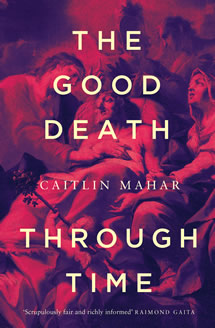Reviewed by Rama Gaind.
By Caitlin Mahar, Melbourne University Press, $35.00.
 How likely is it that our ancestors can help us now to face complex questions of dying?
How likely is it that our ancestors can help us now to face complex questions of dying?
The Good Death Through Time delves into the history of how people’s responses to dying have changed in western societies. We also get to understand when and why other Australians began to find the notion of a physician-assisted death appealing.
This book also asks how such a death became a ‘thinkable’-even desirable-way to die for so many others in western cultures. In particular, it looks at the radical way in which they changed in the course of the 19th and 20th centuries.
“I have quite a bit of understanding of white man’s ways, but it is difficult for me to understand this one.” ― G Ntjalka Williams, Ntaria Council President, 1997
An Australian Senate committee investigation of the Northern Territory’s Rights of the Terminally Ill Act 1995, the first legislation in the world that allowed doctors to actively assist patients to die, found that for the vast majority of Indigenous Territorians, the idea that a physician ― or anyone else ― should help end a dying, suffering person’s life was so foreign that in some instances it proved almost impossible to translate.
For centuries a good death ― the ‘euthanasia’ ― meant a death blessed by God that might well involve pain, for suffering was seen as ultimately redemptive.
This book explores the modern idea that a good death should be painless, bearing in mind sometimes disturbing developments in palliative medicine, and an increasingly well-organised assisted dying movement. We are able to understand the radical historical shift in western attitudes to managing dying and suffering helps us better grasp the stakes in today’s controversies over what it means to die well.
Through unwavering research, Mahar writes an articulate and well-grounded guide to what people have thought and felt about dying.











